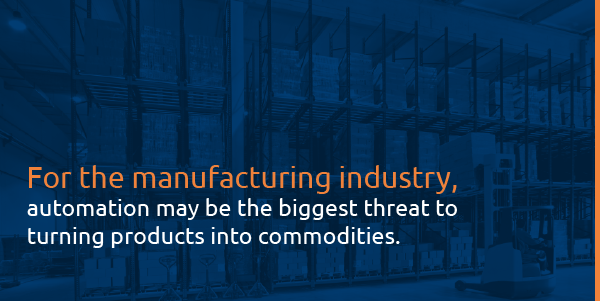Commoditization of Technology

A boom in innovation has rendered many high-tech products mere commodities. Due to the mundanity of many technological products for manufacturers, failing to integrate them into operations will set the company behind. When technology becomes commoditized, using it no longer gives manufacturers an edge but brings them on par with the base level of expected operations. Understanding this idea will allow your business to seek out which technologies it cannot pass up to meet expectations and what it must do to set itself apart as an innovator in the field.
Quick Links
What Is the Commoditization of Technology?
Examples of Commoditized Products
Why Will It Affect Manufacturing?
The Causes
The Effects
How to Navigate Commoditization
Keep Abreast of the Latest Trends in Manufacturing
What Is the Commoditization of Technology?
Commoditization occurs when the latest innovations lose their luster and become a part of expected daily life. The result of this process is dropping prices and a rise in competition among those who provide the service or goods. Since the dawn of the digital age, technology has continued to move forward, but older innovations, such as laptops, and services, such as coding, are now cheaper and more readily available because they have turned into a commodity.
Examples of Commoditized Products
When goods and services only differ in their prices from various providers, they have become commoditized. Several examples of this occur in the technology sector and outside it. For example, only a handful of companies once manufactured and sold laptops and other computer equipment. However, as time went on competitors entered the market, producing very similar computers for different prices. In fact, the only thing distinguishing one company’s laptop from another often is the price with minor variations in the hardware and software. Laptops, therefore, are now a commodity.
When internet availability in the 1990s became open to everyone, a large number of providers erupted on the marketplace, selling faster speeds and better connectivity. In the days of dial-up internet, those companies that could provide connections outside of standard phone lines set themselves apart. Today, however, everyone has high-speed internet available. The differences between providers now come down to cost.
Even products used in the manufacturing field, such as essential tools, have become commoditized through a loss of novelty that new products have. This process does not have to be negative, though. In many ways, manufacturers can benefit from this change and consider the commoditization of technology as a competitive advantage.
Why Will It Affect Manufacturing?
Manufacturing needs innovation to continue to reduce costs and increase productivity. Automation and augmented reality are some of the latest ways manufacturers are embracing to become more efficient. However, the technologies used in years past are so commonplace that not having them puts companies at a disadvantage.
Manufacturers must embrace existing technologies to reach a standard level. After that, using the latest in technology will give your company an edge in productivity and efficiency. You can use the heavy competition of commoditized technologies such as laptops and mobile phones to more cheaply integrate the tools needed for augmented reality and other innovations to improve maintenance and production. Bringing new tools and ideas into your business can set you apart, preventing your service from becoming a commodity.
In addition to innovation, consider segmenting or bundling to keep your work from becoming a commodity. Bundling services or products to make your company different. Segmenting focuses on a single portion of the market that still needs your good or service and for which the price tag is less of a driver of competition.
Yes, commoditizing will affect manufacturing, but if your company can understand why certain things fall into this category, you can successfully navigate the waters of the industry while keeping your company afloat.
The Causes
You would be correct to think technological commodities are increasing in number. Over the years, the speed of innovation and availability of development tools makes it easier than ever for anyone to create high-quality technology products. But this ease of creation is only one factor turning technology into a commodity. Other factors include IP copying, government regulations and knowledge spillover.
1. Copying of Intellectual Property

Corporate knowledge needs tighter security now more than ever. Theft of intellectual property (IP) threatens to turn a proprietary product into something ordinary. Competitors may steal ideas or methods of production to replicate a product, which they can sell at a far reduced price because these companies do not have to make up the cost of research and development of the product.
Such a problem frequently occurs in the technology industry. In 2018, the U.S. Department of Justice (DOJ) accused a Taiwanese and Chinese company of economic espionage. The DOJ alleged these companies stole proprietary technology from American company Micron Technology to create dynamic random access memory chips (DRAM). While the technology of producing DRAM differs little among manufacturers, only a handful of such companies know how to make this technology. In fact, Micron Technology is the only American DRAM producer and has one-fifth of the global production market for this technology.
The availability of the internet and digital documents makes trading in corporate secrets and theft of them more accessible than ever. However, increasing digital security and protecting physical copies of trade secrets are ways companies can prevent IP theft.
2. Government Pressures to Share Technology
Unfortunately, individuals are not the only ones at fault for spreading proprietary ideas. Governments may require businesses to share technology to participate in the company’s marketplace. In 2017, a Reuters investigation revealed the Russian government requiring technology companies to disclose their source codes before the companies could do business in Russia.
Some companies allowed reviews of their source codes because they could not pass up the vibrant technology market in Russia. However, one company that allowed the analysis of its source code reported the independent lab had too close a connection to the Russian government. Officials in the United States warn businesses against sharing their source codes to prevent cyber attacks.
Russia is not the only country to require companies to share technology. Any foreign companies that want to sell their electric vehicles in China must give the Chinese government all technology used in the vehicle’s creation. Failing to do so will block them from selling their cars.
To avoid similar problems with other products, companies like GM and Toyota have partnered with Chinese companies to produce cars locally rather than pay the import tariffs. Unfortunately, working with local companies means the international giants sacrifice their intellectual property’s worth in China while training their future competitors.
3. Knowledge Spillover
Knowledge spillover occurs naturally. Though in an ever-increasingly global market, geography no longer confines spillover to specific areas. Part of the operation of many global production networks is the transferring of knowledge from larger companies to smaller suppliers to maintain the network’s production caliber.
4. Other Factors
These three factors are the leading causes, but other reasons for the trend also abound, though on a smaller level. One of the worst offenders is the amount of knowledge build into tools. Having the right software is the only requirement for creating world-class products now compared to the years of education and experience the technology sector once required.

For the manufacturing industry, automation may be the biggest threat to turning products into commodities. With full automation, parts from various companies produced with similar machines have few differences. Once products become interchangeable among manufacturers, commoditization has occurred.
The Effects
The effects of technology becoming a commodity include both benefits and drawbacks for not only the technology sector but also for the manufacturing industry.
Entering the field costs less and requires less time than ever. Thanks to technology commodities, companies no longer require years of experience or schooling but only ask that new workers can operate the same technology used by the competition. While technology hastens the pace of becoming a competing player in the market, it also makes it more challenging to stand out using standard equipment and technology.
With all companies using the same technology to produce the same products, differentiation reduces. When advertising and price are the only means of differentiating products, something needs to change. Otherwise, only the producers who can make the goods for the lowest cost will prevail. And as the prices plummet, profit margins shrink until it no longer becomes profitable to sell those goods.
Though costs to obtain technological commodities decrease, having these products does not do enough to differentiate your business. Your company needs to take a more proactive approach to navigate the commoditized industry and to prevent your business from becoming a statistic.
How to Navigate Commoditization
Navigating through a quickly commoditizing industry requires proactive participation rather than reactive response. Manufacturing managers have several ways of keeping their company competitive even as technology threatens to commoditize their products.
1. Be Proactive

Don’t wait for changes to occur. Improve operations now so your company does not become lost in the forward movement spurred by technology. Innovate to stay ahead of the curve. You may change your product offerings or your company’s strategy. Whatever your business does, don’t sit idly by.
Choose your business’s customers carefully. Focus your products and services only on those who you want to serve. Ideally, this group of customers will be those to whom price matters less than the products or services you can offer. In such a situation, you can stand out from the competition.
Instead of focusing on sales revenues, look at profit margins. Change sales compensation plans to reflect this focus shift, so sales workers get paid for higher profits rather than sales numbers. Profit focus ensures all sales are profitable rather than just seeking higher closing volume. Ultimately, this strategy benefits your company more with long-term profit goals rather than trying to boost short-term sales.
If you can acquire competitors in your market, do so. Taking competitors under your company’s wing gives you access to their facilities and technology while removing one more competitor in your field. Often, this option is too expensive for small and medium-sized businesses. Strive to reorganize your pricing structure to keep a competitive position in the marketplace while you work toward changing your products to offer different options not found elsewhere.
2. Maneuver
As you seek to change your competition methods, note that the conventional means is through attrition. Rather than using this method to attack your business’s competitors at any cost, instead, work to outmaneuver them.
One way to maneuver around your competition is by looking for gaps in supply in the market and seek to fill those. For example, Airbnb did just that by supplying its customers with the available spaces hotels and other chains did not rent — spare bedrooms and homes.
Rather than relying on funds, which may not be available to smaller businesses, maneuvering relies on agility and speed in the market. Don’t rest on your company’s laurels if success occurs. Always moving and being proactive in your business’s strategy will ensure your manufacturing company does not fall behind from its lead.
If your company can adapt and make quick changes where the need arises, you can come out on top with less investment of funds than other businesses using the attrition method. With proper use of maneuvering, your business does not need excessive funds or a large employee base. Your company has to be intelligently competitive and use insights into the industry to supply needs before the competition does. Working smarter in competitive fields can reduce the amount of money needed to be a contender in the industry.
3. Focus on Enablers
The enablers are those factors that help you to outmaneuver your competitors. Innovation is a key enabler, but so are speed, agility and insight. All these facilitators will help your business keep moving beyond the commoditization that threatens every industry.
Your company does not need to increase its enablers. Use the attributes already present and direct them all to the common goal of maneuvering past others in the industry. When your business takes hold of its available facilitating factors, outsmarting the competition becomes possible. Don’t outwork or outspend your competitors. With planning, maneuvering and using the facilitators available, your company will stand apart even if your products have fallen victim to commoditization.
Keep Abreast of the Latest Trends in Manufacturing
As technology continues to move forward, use the trend to take advantage of the lower costs of commoditized products such as computers and software while striving to add more innovative ideas to your operations. Part of knowing which technologies are worth the use in your business is keeping up with the latest news from the manufacturing industry. Our blog gives you insightful stories about the latest technology, ideas on making your business more productive, how to set your company apart from the rest and much more. Subscribe to get the most recent updates.
Even as you bring new technology into your operations, don’t neglect your existing equipment. We at Global Electronic Services provide repair in as little as one to two days with rush service. You’ll reduce equipment downtime while keeping your machinery operating at its peak performance. Contact us for a quote for the repair, maintenance or replacement of your manufacturing electronics and more.
